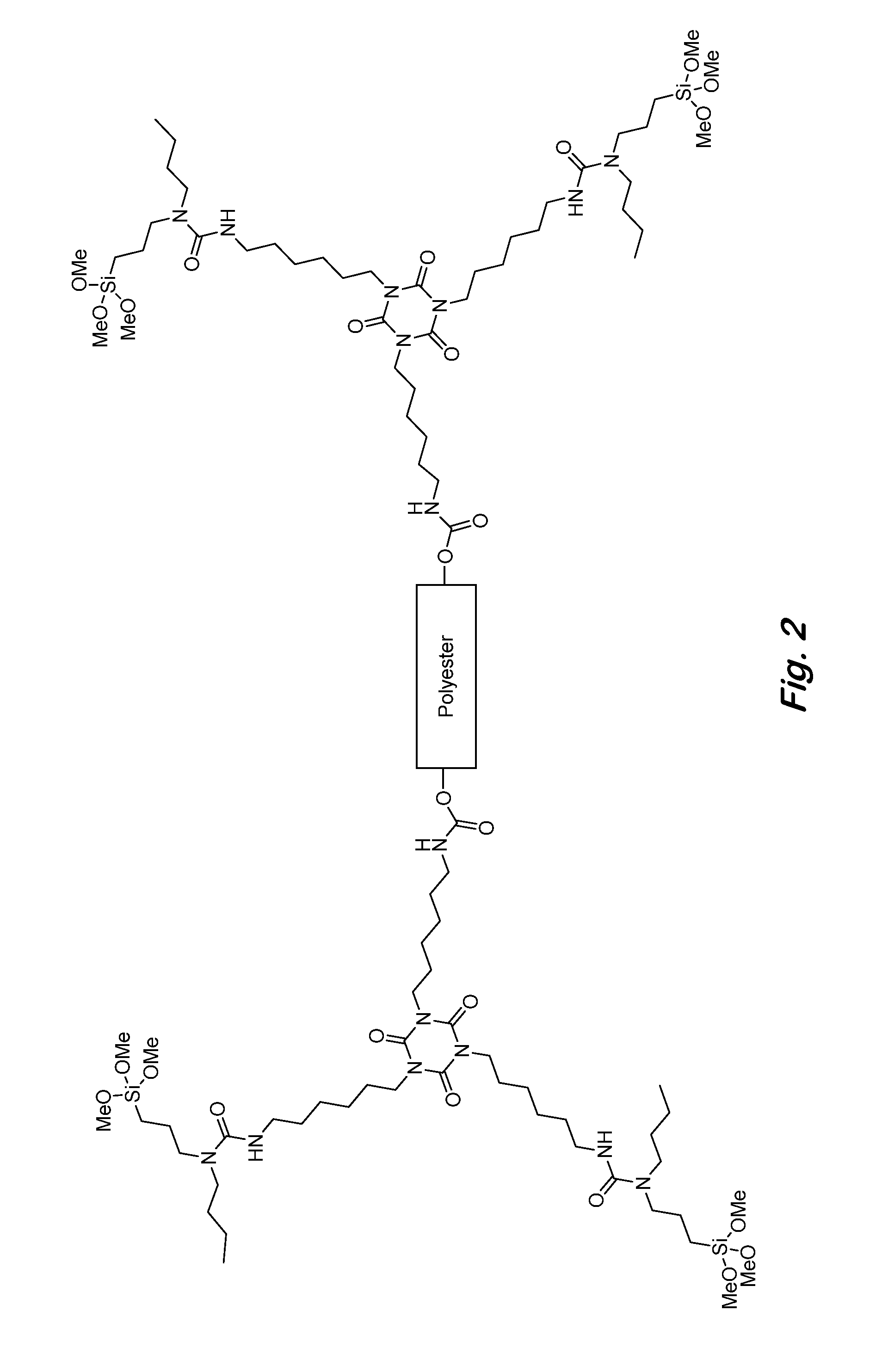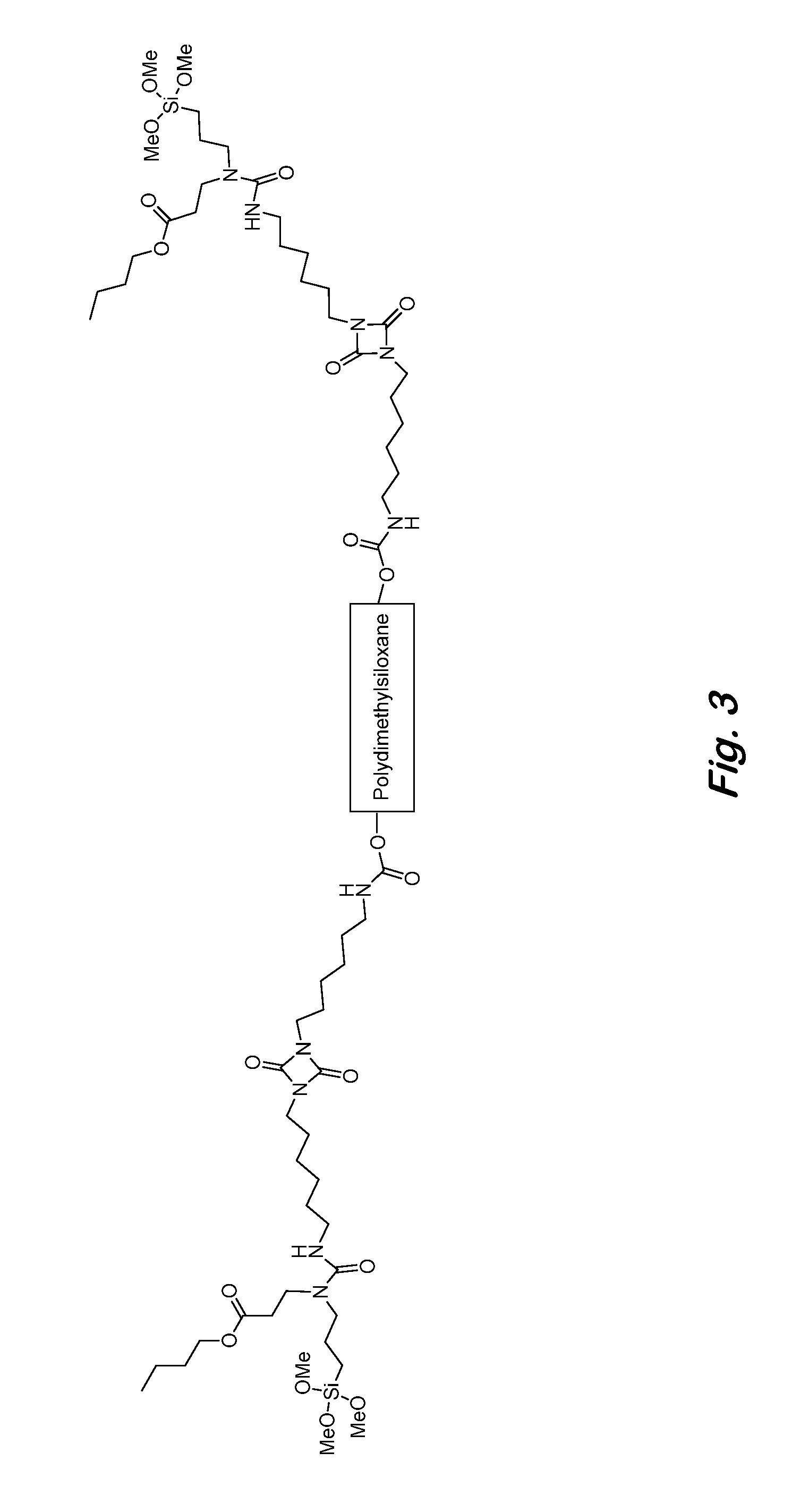Two-component siloxane-based coatings containing polymers with urea linkages and terminal alkoxysilanes
a technology of terminal alkoxysilane and polymer, which is applied in the direction of coatings, polyurea/polyurethane coatings, liquid surface applicators, etc., can solve the problems of poor flexibility and weathering performance, higher molecular weight and less volatile adducts are still considered toxic, and the effect of irritating the eyes, nose, throat, and skin
- Summary
- Abstract
- Description
- Claims
- Application Information
AI Technical Summary
Benefits of technology
Problems solved by technology
Method used
Image
Examples
example 1
Aspartic Ester-Containing Backbone
[0069]86 g (0.445 equiv.) of a hexamethylene diisocyanate homopolymer with mostly isocyanurate trimer structure was dissolved in 74 g of pentyl propionate in a 500 ml 3-neck round bottom flask equipped with an Argon inlet and thermometer. This was followed by the addition of 5 g of vinyltrimethoxysilane as a drying agent. Using an addition funnel, 70.14 g (0.298 equiv.) of N-butyl-3-aminopropyltrimethoxysilane was added dropwise to the solution while keeping the temperature at 40-50° C. Next, 34.4 g (0.147 equiv.) of tetraethyl 2,2′-((2-methylpentane-1,5-diyl)bis(azanediyl))disuccinate (also known as aspartic acid, N,N′-(2-methyl-1,5-pentanediyl)bis-1,1′,4,4′-tetraethyl ester) was added dropwise while continuing to keep the temperature at 40-50° C. After the addition was complete, the solution was stirred for an additional 30 minutes until the infrared (IR) spectrum indicated that no more free isocyanate (NCO) (2270 cm−1) remained in solution. The p...
example 2
Other Backbones
[0073]The flexible backbone of the urea polymers can be aliphatic, cycloaliphatic, aromatic, polyester, polyurethane, polycarbonate, polyether, polysulfide, polysiloxane or a combination thereof, and the N-substituted groups can be C1-C12 alkyl, cycloalkyl, aryl, ester-containing aliphatic, ester-containing fluorinated aliphatic, amide-containing aliphatic, polysiloxane, or any combination thereof. An example of a polymer with a polyester backbone and N-butyl substituted urea linkages is shown in FIG. 2. An example of a polymer with a polydimethylsiloxane backbone and ester-containing N-substituted groups is shown in FIG. 3.
example 3
Bending Test
[0074]A ¼″ Cylindrical Mandrel Bend was performed on the samples. FIG. 4 is a photograph showing the results of the bend test on a prior 2K coating (left) that does not contain the polyurea polymer compared to the presently disclosed coating (right) that does contain the polyurea polymer. The prior coating shows cracking along the bend while the present coating does not.
PUM
| Property | Measurement | Unit |
|---|---|---|
| wt % | aaaaa | aaaaa |
| structure | aaaaa | aaaaa |
| composition | aaaaa | aaaaa |
Abstract
Description
Claims
Application Information
 Login to View More
Login to View More - R&D
- Intellectual Property
- Life Sciences
- Materials
- Tech Scout
- Unparalleled Data Quality
- Higher Quality Content
- 60% Fewer Hallucinations
Browse by: Latest US Patents, China's latest patents, Technical Efficacy Thesaurus, Application Domain, Technology Topic, Popular Technical Reports.
© 2025 PatSnap. All rights reserved.Legal|Privacy policy|Modern Slavery Act Transparency Statement|Sitemap|About US| Contact US: help@patsnap.com



